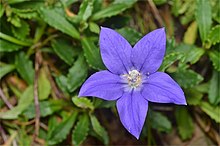Wahlenbergia gloriosa
| Royal bluebell | |
|---|---|

| |
| Wahlenbergia gloriosa in a Canberra suburban garden | |
| Scientific classification | |
| Kingdom: | Plantae |
| Clade: | Tracheophytes |
| Clade: | Angiosperms |
| Clade: | Eudicots |
| Clade: | Asterids |
| Order: | Asterales |
| Family: | Campanulaceae |
| Genus: | Wahlenbergia |
| Species: | W. gloriosa
|
| Binomial name | |
| Wahlenbergia gloriosa | |
Wahlenbergia gloriosa, commonly known as royal bluebell Wahlenbergia gloriosa is a perennial herb with spreading 
Description
Taxonomy and naming
Wahlenbergia gloriosa was first formally described in 1947 by Noel Lothian and the description was published in the Proceedings of the Linnean Society of New South Wales from a specimen collected on Mount Buffalo by Percival St John.[5][6][7] The specific epithet (gloriosa) is a Latin word meaning "famous" or "splendid".[8]
Distribution and habitat
Royal bluebell is locally common in
Use in horticulture
This species is a frost-hardy ground cover that grows best in a sunny or part-shade position in cooler parts of Australia. It can be propagated by division, from cuttings or from seed and grown in enriched soil. It prefers soil with well-rotted organic matter and for the soil to be kept moist but not water logged.[9]
Cultural references
In 1982 Wahlenbergia gloriosa was announced as the floral emblem of the Australian Capital Territory (A.C.T.), by a selection committee chaired by the director of the Australian National Botanic Gardens. The main criterion was its occurrence in the A.C.T. but also because of its horticultural merit and its potential for incorporation in both naturalistic and stylised representations.[10]
A postage stamp featuring the royal bluebell was issued in August 1986.[10][11]
References
- ^ "Wahlenbergia". Australian Plant Census. Retrieved 1 May 2019.
- ^ a b c Smith, Peter J. "Wahlenbergia gloriosa". Royal Botanic Garden Sydney. Retrieved 26 January 2019.
- .
- ^ a b Walsh, Neville. "Wahlenbergia gloriosa". Royal Botanic Gardens Victoria. Retrieved 26 January 2019.
- ^ "Wahlenbergia gloriosa". APNI. Retrieved 26 January 2019.
- ^ Lothian, Noel (1947). "Critical notes on the genus Wahlenbergia Schrader; with descriptions of new species in the Australian region". Proceedings of the Linnean Society of New South Wales. 71: 224–226. Retrieved 26 January 2019.
- ^ "St John, Percival Reginald Harry (1872 - 1944)". Australian National Botanic Garden. Retrieved 26 January 2019.
- ^ Brown, Roland Wilbur (1956). The Composition of Scientific Words. Washington, D.C.: Smithsonian Institution Press. p. 419.
- ^ Halloran, Joe. "Wahlenbergia gloriosa". Australian National Botanic Garden. Retrieved 26 January 2019.
- ^ a b Boden, Anne. "Royal Bluebell". Australian National Botanic Gardens. Retrieved 26 January 2019.
- ^ "Australian Plants on Stamps". Australian National Botanic Gardens. Retrieved 30 April 2021.
